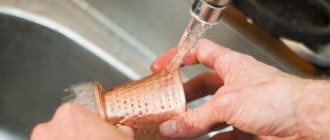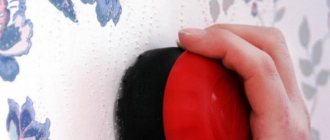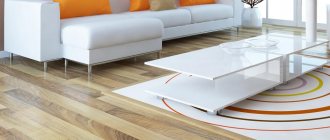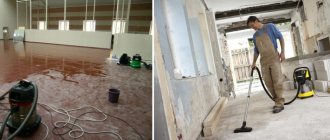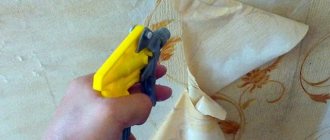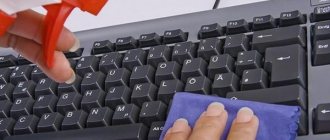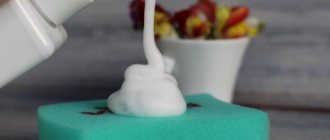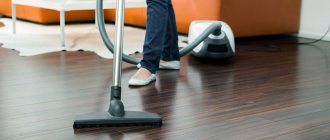Does your wallpaper look a little tired? Over time, dust and moisture can discolor them, leaving wallpapered walls dirtier than the day they were wallpapered.
Someone accidentally smeared a wall in a loved one’s hallway, a little artist decorated the wall upholstery with his “art,” and a greasy stain in the bedroom remained unexplained. But there is no need to give up panic.
We'll show you how to properly clean any dirt from your wall trims.
How to clean wallpaper? Let's first look at the type of wall covering: cleaning paper and tapestry wallpaper will be fundamentally different from cleaning vinyl wallpaper. Rolls of wallpaper are usually marked depending on how much the material can come into contact with water.
How to clean the air from dust in a room?
How to clean your house of dust: 7 simple tips that work
- Tip #1: Get out a little at a time...
- Tip #2: Wipe the dust thoroughly...
- Tip #3: Wash floors only after vacuuming...
- Tip #4: Use a microfiber cloth or similar...
- Tip #5: Don’t forget to change the filters in your vacuum cleaner
Interesting materials:
Juniper is drying up, how to save it? Special mass gainer how to take? What does a call to a session help with? How to calculate the average number of employees in 4 FSS? Cost item material costs what does it relate to? Electronic sick leave status 020 what is it? What is the refinancing rate? Stepper how long to practice? What is a state pension insurance certificate? Holy Week, what can you eat?
White vinegar or bleach
For vinyl stains caused by water damage, whether mold or tannins, try a bleach or white vinegar solution. Start with a weaker solution and add more bleach or vinegar as needed. Mix ¼ cup of bleach with 1 cup of water. First, test the solution on a small, inconspicuous spot on the wall behind the door.
If the method appears to work after five to ten minutes, continue. Dip a soft sponge into the mixture and remove excess water. Apply the sponge to the stain and leave for five minutes. Remove any remaining bleach with a clean, damp sponge.
For dirt or grease stains on fiberglass wallpaper: Use ½ cup white vinegar mixed with 1 cup water. Apply this solution to the painted part of the wall and place it in the same direction as the wallpaper pattern. Wipe the surface with a sponge soaked in clean water. Next is a dry towel.
Advantages and disadvantages of non-woven coverings
Before subjecting the canvas to cleaning and washing, you need to know about its strengths and weaknesses. Features of the coating are:
- First of all, non-woven wallpaper can be washed, because... they are resistant to moisture.
- Air conductivity. Thanks to the small pores in the wallpaper, oxygen is evenly distributed throughout the room.
- Easy to install. Due to the lightness of the material, gluing does not take much effort and time. In addition, the glue is applied not to the product, but to the wall.
- Visually hides small defects in the wall surface.
- Susceptibility to translucency. If you do not use a neutral-colored primer or do not paint the canvas after gluing, everything will be visible when exposed to sunlight.
How to wash washable wallpaper, how to clean paper, vinyl, non-woven wallpaper
The moisture resistance of the coating must be taken into account. Compact vinyl and silkscreen are considered the most durable. They can be cleaned even with a heavily moistened brush. Cleaning with a washing vacuum cleaner is also an available option.
Expert opinion
Ksenia Diyanova, expert on beauty, purity, harmony
Ask me any questions, I will be happy to answer!
Dirt from their surface is washed with a soft cloth slightly moistened in a weakly concentrated soap solution. Coatings based on latex or water-dispersion paints make it possible to carry out wet cleaning. How to wash wallpaper at home: 9 folk methods Ask me all your questions, I will be happy to answer!
Floor cleaning
The floor is washed last, when all surfaces are cleaned of dust and all dust has fallen off. Necessary:
- First, use a large rag to collect everything that might have fallen. Particular attention should be paid to baseboards, corners and the space under the radiator and furniture. The more thoroughly this stage is completed, the less effort will have to be made further.
- Then wash in small areas again, constantly rinsing the rag. You will have to repeat twice.
- At the end, for shine, they are treated with a product suitable for the specific floor for parquet, laminate, tiles, and so on. Detergents are used only on the floor, on the walls only if there are tiles on them.
- After this, all surfaces must be allowed to dry.
- At this time, curtains, carpets and all other items are washed.
- When the floor is dry, you can put everything back.
A few simple rules will help make cleaning up construction dust after renovation easier, faster and more efficient:
- If during repairs you cover all unused surfaces with construction film and seal the edges with paper tape, after the film is removed, less dust will remain.
- Cleaning is done throughout the entire apartment. You need to start in the room farthest from the exit.
- The first steps (taking out the trash and vacuuming) must be done everywhere at once. Continue from one room to another, making sure to close the doors.
- When cleaning, it is better to work in rubber shoes that are easy to rinse or shoe covers. Constantly change them as they become dirty.
- When the cleaning of construction dust after renovation in a room is completed, no more people enter it until the cleaning of the entire apartment is completed.
- In the days following cleaning, the dust will still gradually settle. Therefore, it is advisable to walk over surfaces with wet wipes or damp cloth during the first week. Do wet cleaning of the floor.
- Having a humidifier will also help. Wet dust particles will settle on the floor rather than in your lungs. This is especially true for allergy sufferers and asthmatics.
Repairs are always associated with a huge amount of debris and post-repair work. None of them should be skipped to get the desired result. Cleaning is a monotonous and labor-intensive process, but it brings the result to perfection. After all the work done, you can finally enjoy the cleanliness and updated interior.
Liquid
- Prepare an aqueous solution of baking soda at the rate of 20 g of soda per 1 liter of water. Use a sponge soaked in liquid (should not run off, squeeze out excess) to wash away dirt from the wallpaper. Then wipe the treated surface with a cotton rag soaked in plain water.
- Prepare a soap solution. Proceed as in the previous case.
An effective remedy in the fight against greasy stains is pure alcohol, solution or alcohol tincture. The main thing is that the liquid is transparent and does not leave any traces. You can spray it on the canvas or gently rub the stains with a cotton pad. Alcohol copes with grease, markers, felt-tip pens, traces of aerosol products, air fresheners, and mosquito sprays.
Removing greasy stains
- Immediately after completion of repair work, all large debris is removed. Collected in large bags and tools. Bags should not be stored in the apartment. It's better to take it out of the house right away. Tools must be cleaned so that any remaining dust on them does not fly around the apartment.
- After large debris has been removed, you can proceed directly to cleaning up construction dust after repairs. First you need to remove the curtains and remove all free-standing decorative elements, flower pots, carpets, and so on. They are washed and cleaned separately. All non-woven items are immediately wiped with damp towels.
- Next, you need to make sure that the dust settles. To do this, spray all surfaces with water from a spray bottle. This includes working on the ceiling, walls, all shelves, window sills, furniture, baseboards, and so on. Dry dust rises from the slightest movement or blow of wind. Therefore, you must immediately close the windows and doors. While cleaning, you can continue to spray surfaces to prevent them from drying out.
- It is best to use a vacuum cleaner to remove dust after repairs. A broom or squeegee only raises dust, and it will settle again. In addition, it is more convenient to use a vacuum cleaner to clean walls, furniture and ceilings.
- After the construction dust has been vacuumed, it is necessary to do wet cleaning. This process will need to be repeated at least 2-3 times. You should start by treating with plain water. Water and matter need to be changed as often as possible, this way there will be fewer stains. Then let the water dry and walk again. For the third time, you can add detergents to remove all the stains.
- Finally, everything that was taken out at the very beginning is washed, washed, cleaned and returned to the already clean room. Now you can hang the curtains and open the windows.
Below we will present folk and professional methods for removing stains.
How to wash washable wallpaper
Vinyl is a type of washable wallpaper. Wallpaper made on a paper basis, but coated with a special varnish that does not allow water to pass through, is also considered washable.
Wet wiping of such products requires great care and is carried out in compliance with the following rules:
- Prepare a cleaning solution as for non-woven wallpaper.
- Lightly moisten the sponge, cloth, microfiber, and apply a small amount of foam.
- Without applying much pressure to the wall, blot the wallpaper with a sponge.
- Remove excess moisture with a dry cloth.
Tests should first be carried out in a separate area. If it was not possible to wash off all the dirt the first time, repeated cleaning begins only after the material has completely dried. Otherwise, there is a high probability of damage to the outer layer and destruction of the paper layer.
How to wash washable wallpaper, how to clean paper, vinyl, non-woven wallpaper
- Remove dust with a vacuum cleaner turned on at minimum power.
- Prepare an aqueous solution based on laundry soap (you can use dishwashing liquid or shampoo instead) in a ratio of 1:10.
- Soak microfiber or foam rubber with liquid.
- Wipe the surface from bottom to top to avoid smudges.
- Remove excess moisture with paper or cotton towels.
Non-woven wallpaper allows you to hide significant unevenness in the walls and, if treated with care, is designed for a long service life.
How to wash washable wallpaper, how to clean paper, vinyl, non-woven wallpaper |
- Using talc. Pour talc onto a sponge, rub the greasy stain, leave for 10 minutes. Remove any remaining talc.
- Using paper. Place a clean sheet of white paper on the stain. Iron the sheet with a warm, but not hot, iron until the paper has absorbed all the fat. Change paper whenever it gets dirty.
The felt-tip pen is washed off the walls with a solution: 100 ml of water, 10 g of oxalic acid, 10 g of citric acid. Dip a cotton swab or disk into the liquid and apply to the drawings.
The difference between wallpaper and dirt on it
Wallpaper in kitchens and bathrooms can become coated with sprinklers, smoke and vaporized oils, creating a sticky surface where dust can easily stick and obscure the wall.
Meanwhile, wallpaper in the bathroom, where it is exposed to high humidity and splashing water, can become moldy where it comes into contact with dampness. If it is very saturated, such as due to a leak or burst pipe, water may also seep through the walls and release tannins from the underlying wood, staining your wallpaper.
If you have cellulose, fabric, bamboo, hybrid or removable wallpaper , you can clean it by only lightly dusting or vacuuming the walls. Many natural fibers and fabrics can be damaged by water and cleaning chemicals, so check with the manufacturer before staining.
The exception is vinyl and fiberglass wallpaper - the most durable of all. Either can be cleaned using all-purpose cleaning sprays or the gentle cleaning method described above.
However, be careful to work with non-abrasive chemicals (no powders) and only soft scouring pads or sponges (no scouring pads) to ensure you don't scratch, tear or damage the surface. Do not use scrubs that contain very fine abrasives.
Source
How to wash paper wallpaper
Advice! The dirt can be covered up with a decorative element that matches the interior or the problem area can be covered with new wallpaper.
Conventionally classic wallpaper that can withstand wet cleaning can be divided into several types:
Do you like guys with long hair?
Not really
- paper, thin wallpaper made of paper, coated with a special moisture-resistant varnish, most often used in kitchens and hallways,
- vinyl, kitchen-themed wallpaper, material foamed and fixed with inhibitors, soft and pleasant to the touch,
- silk-screen printing, very strong and thin vinyl with added fabric fibers,
- Hot-stamped vinyl on a non-woven backing, usually in long, meter-long rolls that can withstand very harsh washing.
Paintable wallpaper, liquid wallpaper, metal, wood and other non-standard moisture-resistant types of wallpaper can also be washed.
As dust and dirt accumulate on the wallpaper, the time comes for decisive action; now, armed with cleaning products, cleaning and washing operations are carried out.
But not all cleaning products can be used; there are certain nuances for different types of wallpaper, which will be discussed.
Melamine sponge
This abrasive removes various “fresh dirt” well. But he can’t cope with the old-timers:
- The sponge is great for cleaning vinyl surfaces.
- Non-woven wallpaper cannot be cleaned without damaging the texture and pattern.
- And melamine abrasive is generally the worst enemy of paper.
arrow_left
The melanin sponge perfectly removes fresh stains
Removing brilliant green
- One wave. A full wash is excluded. Only gentle wiping with a damp cloth is possible.
- Two waves. The coating can be washed with the addition of a soap solution, but remember to be careful.
- Three waves. The use of any household chemicals is permitted. They have high resistance to moisture.
- Waves with crest symbol. Super durable wallpaper. It is acceptable to use brushes and a washing vacuum cleaner while washing. The price of such products is the highest, but in conditions of increased pollution it is quite justified.
Important! It is prohibited to use aggressive liquids containing acid and abrasive components.
Construction waste removal
Removing construction waste is the first step of general cleaning. All construction waste must be placed in bags, hermetically sealed and removed from the house. In this case, the windows should be closed so as not to collect dust again. All large debris that can be collected manually is also immediately removed. These are pieces of concrete, polyurethane foam, polystyrene foam, and so on.
It is imperative to clean tools that will not be thrown away from construction dust. It is important not to miss anything, because as soon as a forgotten item is disturbed, the dust from it will fly everywhere. And dust removal after repairs will have to start all over again.
Furniture preparation
When the bulk of the dirty work is completed, it's time to start washing and cleaning the furniture. If you purchased a new one, all you need to do is uncover and vacuum it. If the sofas, armchairs and tables are the same, then to update the interior they need to be given more attention.
- Reupholster your upholstered furniture. To do this, use the services of specialists.
- Clean contaminated areas from rust, dirt, debris, and stubborn stains.
- Treat wooden surfaces with polish.
- Wash the plastic elements with a damp cloth and then wipe dry.
- If upholstered furniture has an unpleasant odor, then it is better to first take such items to dry cleaning, where they will be brought into proper condition.
- Do the same with carpets and rugs. Everything in the house should be fresh and washed.
- Don't forget about cabinets and built-in appliances. Get rid of dust. Rinse them very thoroughly on all sides. To avoid streaks, wipe dry.
